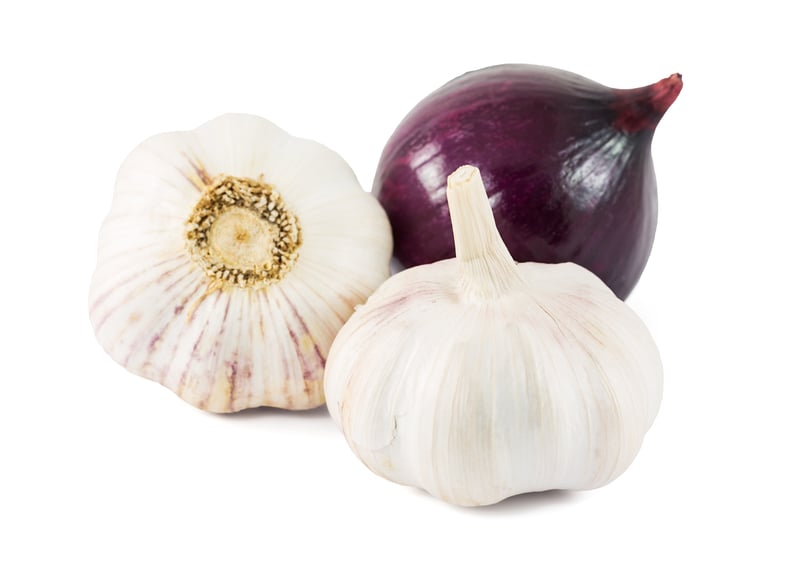The Top 7 Foods That Cause Bloating and Gas (see the list)

Your belly is swollen, round, and distended. You have to be careful how you move so nothing “escapes.” Yep, you’re feeling bloated, gassy, and seriously uncomfortable! All of us have been there at some time or another, and at least 25% of folks experience bloating regularly. What’s causing all this discomfort? While bloating may be caused by a medical condition (although it’s rare, you may want to check with your healthcare professional first to rule out any more serious issues), it’s more likely that you’re eating foods that cause bloating and gas.
And while everyone gets gas and/or bloating some of the time, others certainly seem to experience it more often. The average person passes gas around 13 to 21 times a day. (So, no, it’s not just you.) It’s a normal part of the digestion process, often the result of fermentation of undigested substrates (like fermentable fibers) by gut bacteria, which yields rather high levels of hydrogen, methane, and carbon dioxide. And much of the time, it’s not even noticeable as the “wind” is made up of odorless gases. (Other times, depending on the composition of gases, it may also clear the room.)
Here are some of the top dietary culprits of gas and bloating.
7 Foods That Cause Bloating and Gas
1. Beans and legumes. As children, most of us learned the fun song, “Beans, beans, the musical fruit, the more you eat, the more you toot…” So, you probably could have guessed this category is high up on the list of foods that cause bloating and gas.
However, there are many potential benefits of eating these high-fiber, nutrient-dense plant-based foods (which are also a great source of protein), and for those who regularly eat beans, the flatulence claims may be highly exaggerated. The type of beans may also make a noticeable difference. In one study, less than 50% of people noticed increased gas from eating pinto or baked beans, and just 19% found an increase after eating black-eyed peas. Other easier to digest beans include adzuki and mung beans.
To help reduce the amount of gas you pass after eating beans and legumes, try soaking them before cooking and start with smaller servings to build up good bacteria to better digest them without excess gas. Eight to 12 weeks is typically enough time to reduce digestive symptoms.
2. Dairy. For those who are sensitive to lactose (the sugar found in milk), gas and bloating are some of the most common signs of the malabsorption. Lactose intolerance is typically the result of insufficient production of the enzyme lactase, which is needed to break down lactose sugars in the small intestine. Dairy products include not only milk but also cheese and yogurt, which tends to be less problematic since the fermentation process results in the breakdown of the majority of lactose.
While many people with a milk sensitivity have issues with lactose, some people who believe they are lactose intolerant (due to bloating and gas, for example, experienced after consuming dairy) are actually sensitive to other components found in milk, such as casein protein.
There are lactose-free milk and dairy alternatives available. And because whey, butter, and ghee provide very small (if any) amounts of both lactose and casein, many people with milk sensitivities are able to consume those.
3. Grains. Especially if you are sensitive to the gluten protein found in wheat, you can experience gas, bloating, discomfort, etc., after consuming gluten-containing grains such as wheat, bran, rye, and barley. And while gluten is most frequently dubbed a probable suspect, grains contain other components (e.g., FODMAPs, trypsin inhibitors) that may also contribute to bloating in sensitive folks.
Yet even if you aren’t intolerant, the resistant starches found in grains can travel down to the large intestine to ferment and create gas. Try oats, buckwheat, wild or brown rice, quinoa, or almond or coconut flours as alternatives if you find yourself sensitive to gluten. You might also find that sprouted grains are friendlier options.
4. Cruciferous vegetables. Bok choy, broccoli, Brussels sprouts, cabbage, and cauliflower are nutritious vegetables that most of us are told we should eat more of. However, they are loaded with difficult-to-digest components, like fiber, raffinose, and sulforaphane, which can lead to (often stinky) gas.
Yet because they are loaded with health-promoting nutrients like vitamins C and K, fiber, and potassium, it’s best not to avoid them. Instead, to help reduce the amount of gas produced from these nutrient-dense foods, cook, ferment, or steam them before eating (rather than consuming them raw) and start with smaller “doses,” slowly increasing your consumption.
Other vegetables known for causing excess gas include asparagus, artichokes, corn, and sprouts.
5. Garlic and onions. High in fructans (a soluble fiber that’s also a FODMAP), these vegetables (as well as leeks, wheat, and agave) are well-known foods that cause bloating and gas. Fructans travel through the small intestine undigested, passing along to the large intestine where they are fermented by gut bacteria, resulting in high amounts of hydrogen and methane being produced. To help avoid leaving behind stink bombs, reach for green onions, celery, fennel, and other spices to flavor foods if you find you don’t tolerate them well.
6. Some fruits. While they’re loaded with nutrients including fiber, vitamins, and antioxidants, apples and pears can also be filed away as foods that cause bloating and gas because they’re high in fructose and sorbitol, two more poorly digested carbohydrates. Other fruits that may cause excess gas include apricots, cherries, peaches, plums, and prunes.
Cooking these fruits may help, or you may choose to go with other fruits that are less likely to cause bloating and gas like bananas, berries, cantaloupe, citrus fruits, and grapes.
7. Mushrooms. Like many of the foods above, certain components of mushrooms are often not fully digested before leaving the small intestine, so they enter into the large intestine where there are fermented, which then creates intestinal gas.
Other Helpful Gas & Bloating Tips
If you are one of the many people who experience bloating and gas from time to time, here are some additional tips to help avoid discomfort:
- Avoid eating too much at a time. The old adage to eat until 80% full can also be effective to help beat the bloat. Give smaller portions a try, eat mindfully, and avoid eating until you feel “stuffed.”
- Avoid constipation. Uncomfortable on its own, constipation can also make bloating and gas worse. Ensure you are consuming enough soluble fiber (work your way up to avoid making gas and bloating worse), drink plenty of water, and ensure you are physically active to keep your digestive system moving.
- Don’t eat too fast. Remember to fully chew your foods to avoid swallowing air with your food, which encourages you to eat more slowly so you can tune in to your body’s cues before you overeat.
- Don’t change your diet too fast. The bacteria in your gut (microbiota) can take time to adjust to changes in diet, so if you make big dietary swings, you may experience excess gas. This can include a single meal that’s heavy, exotic, or loaded with fiber.
- Avoid fizzy/bubbly drinks. Carbonated beverages, such as sodas, sparkling waters, and beer, contain carbon dioxide (it’s what makes the bubbles). And those gases are still released after the drink reaches the stomach, which can lead to bloating and gas.
- Avoid chewing gum. While gum may help freshen your breath, if you are suffering from gas and bloating, you may want to give up the habit. It can cause you to swallow air, leading to those symptoms. Sucking on candies can also cause you to swallow air and lead to bloating and gas.
- Experiment with a low-FODMAP diet. Especially helpful for folks with re-occurring symptoms of bloating and gas (or even irritable bowel syndrome, or IBS), eating a low-FODMAP diet may help relieve unpleasant symptoms. FODMAPs, which is an acronym for fermentable oligosaccharides, disaccharides, monosaccharides, and polyols, are poorly absorbed carbohydrates that are more difficult to digest in the upper GI tract, so they often find their way into the lower gut intact. The bacteria in the gut then go about trying to break them up (via fermentation), which can lead to bloating, gas, and other digestive-related complaints.
- Embrace digestive enzymes. While you can’t necessarily eat anything you want and expect to suffer no consequences, when you do eat “suspect” foods that typically cause bloating and gas, you may want to reach for a digestive enzyme supplement to help with the breakdown of difficult-to-digest carbohydrates. A quality prebiotic/probiotic supplement or activated charcoal may also help.
Foods that Cause Bloating: A Wrap Up
While the anatomy of the digestive system is fairly similar from person to person, digestion varies considerably across individuals, and foods that cause bloating or gas for you may not affect the people around you, and vice versa. So, if you are currently suffering, you may want to remove some or all of the culprits from your diet and then slowly re-introduce them, one at a time, to see which ones you’re most sensitive to. And if you aren’t able to determine what foods are causing your bloating or gas, you may want to work with a dietitian or healthcare practitioner to help you get to the bottom of what’s causing your issues.







